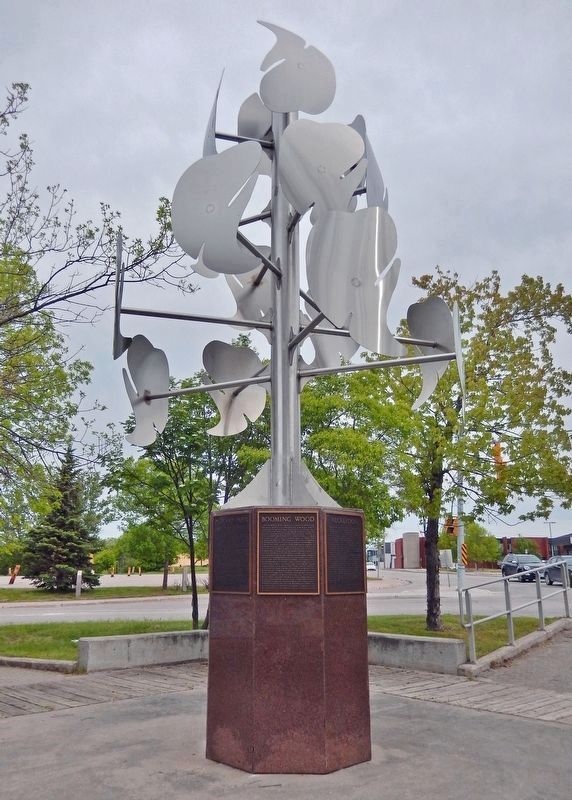Dryden in Kenora District, Ontario — Central Canada (North America)
Booming Wood
Before World War II, most of the wood supply for the mill as well as the several saw mills which operated in Dryden was delivered by water. The wood was cut generally in the winter around the hundreds of miles of shore line of Lake Wabigoon and its many branches and tributaries. It was hauled to the lake by horses and sleighs and dumped on the ice. The company owned many horses, however, people from as far as Saskatchewan would come with their teams to earn some extra money in winter hauling wood. The biggest trees were cut into boom logs which were fastened end to end to form booms. A boom would be drawn around a quantity of floating wood and the ends attached to a tug boat — in the early days steam powered, later diesel powered. Depending on the size of the tug the quantity of wood could run into thousands of cords — the biggest load on record was 4100 cords. These large tows of wood moved very slowly — and could take up to a week to make a round trip, during which the crew lived on the boat.
After World War II more and more wood was hauled to the mill by truck, and as the stand within ready access of Wabigoon Lake and its tributaries became depleted water transfer of wood declined and eventually disappeared. The last tow was brought down the lake by the Anglo Duchess on June 13, 1977. The river continued to be used to sort and transfer wood into the mill until July 29, 1982, when the last tow was brought down the river by riverboat Dryden 4 to the mill slasher located on the point of land directly south of where you are standing.
Topics. This historical marker is listed in these topic lists: Horticulture & Forestry • Industry & Commerce • Waterways & Vessels. A significant historical date for this entry is June 13, 1977.
Location. 49° 46.916′ N, 92° 50.462′ W. Marker is in Dryden, Ontario, in Kenora District. Marker is at the intersection of West River Road (Duke Street) (Provincial Highway 594) and Earl Avenue, on the right when traveling east on West River Road (Duke Street). The marker is mounted on the granite base of a metal sculpture at the southwest corner of the intersection, overlooking the Duke Street Dock. Touch for map. Marker is at or near this postal address: 18 Duke Street, Dryden ON P8N 1Y1, Canada. Touch for directions.
Other nearby markers. At least 8 other markers are within walking distance of this marker. Pulp and Paper (here, next to this marker); Recreation (here, next to this marker); Gold Fever (here, next to this marker); The Present (here, next to this marker); Beginnings (here, next to this marker); The Railway (here, next to this marker); Agriculture (here, next to this marker); Alan Durance (within shouting distance of this marker). Touch for a list and map of all markers in Dryden.
Related markers.
Click here for a list of markers that are related to this marker.
Also see . . .
1. 100 years and beyond – Dryden Mill, by Gwen Johnston (pdf). Excerpt:
In the spring, the logs staged at landings on area waterways would be run downstream to Wabigoon Lake. Once on the lake, these logs were combined with others that had been staged on lakeshore skidways and boomed together into tows of about 2500 cords to be pulled across the lake and down the river with tugs.(Submitted on March 15, 2024, by Cosmos Mariner of Cape Canaveral, Florida.)
2. Saving History by Restoring Artifacts: The Dryden 3 Tug. Excerpt:
Logging had a vital role in the economic development of communities in Northwestern Ontario and northern Minnesota. Tugboats towed and hauled log booms of logs down rivers and lakes to paper mills. And one of the tugs used by the paper mill in Dryden, Ontario was the Steelcraft warping tug, Dryden 3, one of five tugs that up until 1981 were used to haul log booms to Dryden.(Submitted on March 15, 2024, by Cosmos Mariner of Cape Canaveral, Florida.)
Credits. This page was last revised on April 21, 2024. It was originally submitted on March 14, 2024, by Cosmos Mariner of Cape Canaveral, Florida. This page has been viewed 30 times since then. Photos: 1, 2. submitted on March 15, 2024, by Cosmos Mariner of Cape Canaveral, Florida.

